#fan clubmoss
Explore tagged Tumblr posts
Text















Autumn on Snake Hill.
Elevation makes a huge difference in the Central Appalachians. Canaan Valley was at peak color almost two weeks ago. A thousand feet lower, at Snake Hill Wildlife Management Area, the leaves are just starting to approach peak. From top: red maple leaves drape fan clubmoss; the white-glazed, blue-purple berries of common greenbrier, an important food source for wildlife in the fall and winter; oldfield aster, also known as frost aster; milkweed pods release their precious seed; goldenrod gone to seed; the blue-black berries of mapleleaf viburnum, whose blushing red leaves are one of autumn's great joys; the brilliant yellow foliage of wild yam; the fiery red bolts of sourwood's dying flame; red oak burning away at the trail's edge; eastern teaberry loaded up with its distinctive red berries; a gorgeous Maryland golden-aster, one of the last beauties standing before the frost; and a spotted cucumber beetle, which despite its innocent appearance is a bane of late season gardens.

#appalachia#vandalia#west virginia#wildflowers#flora#fall#autumn#leaves#foliage#insect#snake hill wildlife management area#chestnut ridge#fan clubmoss#red maple#common greenbrier#common milkweed#canada goldenrod#mapleleaf viburnum#wild yam#sourwood#red oak#eastern teaberry#maryland golden-aster#spotted cucumber beetle
101 notes
·
View notes
Note
random hc questions for you, if you're up for it! does azrael have any scars? what's the story behind them? is she right or left-handed? what's her favorite plant / flower? does she have any special or unusual talents? being billions of years old, does she have a favorite historical era? does she prefer cookies or cupcakes? (you can answer all of these, none of these, or pick & choose! just wanted to send you something fun 💙)

Of course, I'm up for it! ❤️
1.) Does Azrael have any scars? If so, what's the story behind them.
So, because Azrael's vessel eventually heals all damage, she can't retain scars. That goes for gunshot wounds and terrestrial stuff (superficial damage that cannot kill Azrael or cause her pain) and damage inflicted by empyrean steel or white fire (which can kill Azrael and cause her pain). Azrael would have quite a few if she could retain scars, being an ancient warrior and veteran of a thousand-year war. During the Battle for the Third Heaven, her first wound was received from one of her former Captains, Captain Senahel. She was stabbed through the right wing by Senahel's long sword. Senahel did not survive her brief fight with Azrael. The Loyalist army (led by Azrael and Michael) won the Battle for the Third Heaven, and Lucifer's rebel army lost half its forces, forcing them back to the Second Heaven. Around 220,000 angels were killed on both sides during that one battle.
A thousand years later, when Azrael fought Lucifer to stop him from taking the throne of the Almighty, she received most of her wounds.
With his empyrean steel sword, he slashed her vessel's abdomen, severed both her Achilles tendons, and cut her left-wing from top to bottom. Azrael almost died, as the wounds dealt to her vessel were also dealt to her original form (a.k.a her light). This was the last battle of the war before Lucifer and the rebel army were thrown out of Heaven.
She would also have a scar on the palm of her left hand, which she received from a human woman named Brid, who was the pregnant wife of a rogue Watcher angel called Mydaiel. Azrael was there to kill the rogue angels, along with their wives and their unborn children, because it was forbidden for angels to have relations with humans or to conceive children. Brid stabbed Azrael through the left hand to slow her down, but unfortunately, it wasn't enough to stop her. Azrael killed Brid, Mydaiel, their unborn baby, and all the other wives, angels, and Nephilim living in the settlement. Seventy-five people fell to Azrael's blade that day, so, eh, Azrael deserved to get stabbed in the hand at the very least.
2. Is Azrael right or left-handed?
She is ambidextrous, but she favours her left hand when she writes.
3.) What is Azrael's favourite flower or plant?
It would have to be between the 'centipede clubmoss' Leclercqia scolopendra, which grew on Earth during the Devonian period (about 370 million years ago). Azrael always thought it looked rather unique up close. OR pixie cup lichen, Cladonia asahinae. I think Azrael is a fan of moss and lichen.
4.) Does Azrael have any special or unusual talents?
Because she was purpose-built by the Almighty for leadership, Azrael is a cunning and persuasive politician, a rousing public speaker, and a gifted military tactician.
Azrael is also a virtuoso. She plays the Violin and Piano at an expert level but only classical pieces (unlike Lucifer, who plays stuff like Depeche Mode). She is also a great Ballet dancer. I'm not sure these count as talents because they are largely because she is an Archangel, but she can hold a one-handed handstand for hours.
5.) Being billions of years old, does Azrael have a favourite historical era?
It's hard to say because Azrael knows, from experience, that there are no times in human history when humans haven't been awful. On the one hand, she found the 'Age of Enlightenment' encouraging because more people started to question the rule of the Vatican, which had already caused so much suffering. But then, there was also so much darkness. Perhaps Azrael would choose the Renaissance for the great works of art produced by humanity, the works of the Ming dynasty, the creation of the Korean 'Hangul' alphabet, the Sistine Chapel etc.
6.) Does Azrael prefer cookies or cupcakes?
Azrael prefers a nice biscuit, like a shortbread or two.
2 notes
·
View notes
Text
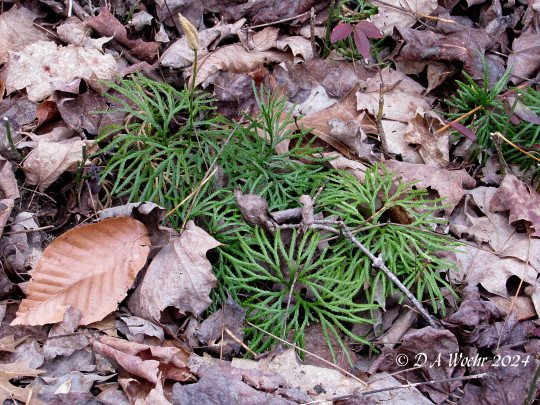
Fan Clubmoss by Picsnapper1212
1 note
·
View note
Photo
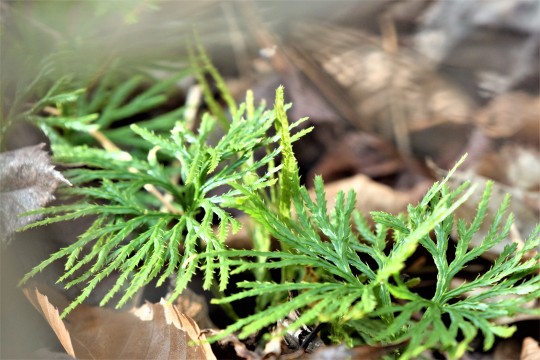
Spider Acres Native Plants: Fan Clubmoss (Running Cedar, Ground Cedar, Crowsfoot) Clubmosses evolved about 410 million years ago as one of the earliest groups of vascular plants. They were once widely harvested and sold as Christmas greenery, and populations were depleted for this reason. However, they have since recovered and make large clonal colonies, carpeting the forest floor. Spores are highly flammable due to the high content of oil they contain. They have been used culturally for ceremonial purposes when medicine men tossed the spores into a fire for a flash of light and also used as a primitive flashpowder.
#clubmoss#fan clubmoss#running cedar#native plants#nc mountains#ground cedar#crowsfoot#nature photography#photographers on tumblr
9 notes
·
View notes
Text
The woods in the Adirondacks were so pretty. It wasn’t a true old growth forest as it looked like it had been cleared maybe 50 years ago, but there were few deer and therefore it had more of an understory. I was excited to see many trilliums even though they were post-bloom because they’re not by me. I also saw many lady’s slippers, eastern newts, princess pines and fan clubmoss, giant Solomon’s seals, wild columbine, and many more natives. The nice thing about not competing was that I was able to take my time and dismount to take pictures of all the plants I liked. And despite that, we still finished the 30 miles in the nick of time even though we started an hour later than everyone else. I’m also happy because I did get some nice professional ride photos. I wasn’t sure if they were going to still take pictures of us if we weren’t competing, but they did. They haven’t been sent to me yet, though.
34 notes
·
View notes
Text
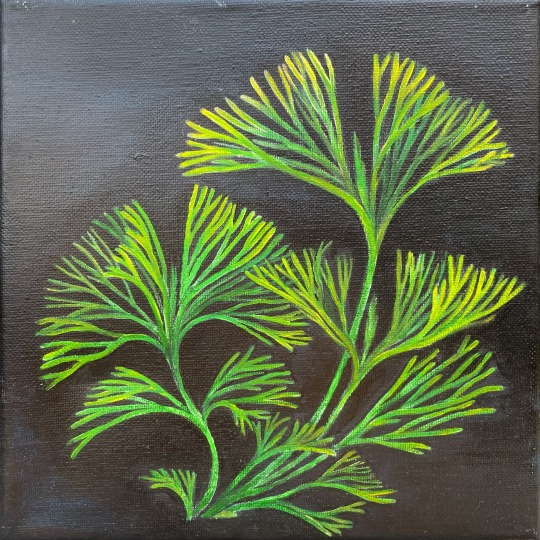
very basic painting of some fan clubmoss (𝘋𝘪𝘱𝘩𝘢𝘴𝘪𝘢𝘴𝘵𝘳𝘶𝘮 𝘥𝘪𝘨𝘪𝘵𝘢𝘵𝘶𝘮) that i did a lil while ago
15 notes
·
View notes
Photo


Dendrolycopodium dendroideum
An indicator that you no longer are looking at Diphasiastrum digitatum is that this fan club moss doesn’t form dense colonies by stolon and has many levels to it’s branching. The scales are no longer densely appressed in a terete form, instead they are open enough to glance at the ligules hiding in each scale with a hand lense. This species is much larger then Dendrolycopodium hickeyi, Jim Hickey’s fan club. Aside from that Dendrolycopodium spp. are known for a non stalked strobili. Dendrolycopodium hickeyi has many strobilii on average while this species seems to produce few. Another close look alike is a species called “rare club moss”, Lycopodium obscurum, which does have tree like branching but has specific hair like tips to it’s terminal scales.
So, other clubmosses with cone-like strobili: Spinulum spp. = have stalkless strobili but lack tree-like branching, Lycopodium spp. = stalked strobili and pseudo-awl with hair-like tips, and Diphasiastrum spp.= stalked strobili and scale-like pseudo-awl super appressed with a terete form. Huperzia spp. are more snake like with their dichotomous branching being more distinguishable and overall- large.
#Diphasiastrum#diphasiastrum obscurum#dendrolycopodium#Dendrolycopodium dendroideum#lycopodium#lycopods#vascular plants#botany#lycopodaceae#kentucky
18 notes
·
View notes
Text
lycopodium
LYCOPODIUM CLAVATUM
Today, let’s perceive the remedy genus Lycopodium and apprehend everything regarding this drugs.
General introduction:
Lycopodium Clavatum, unremarkably referred to as Wolf’s Foot or Clubmoss belongs to the clubmoss family family of kingdom. it's referred to as vegetable Sulphur. Medicine is ready victimisation tincture of spores and tincture of contemporary plants. Lycopodium incorporates a marked action on the subsequent elements - Hair Gastrointestinal system Male and feminine genitals Urinary system Skin, etc. Click here for online medicine
Constitution of a genus Lycopodium Patient:
Lycopodium could be a deep acting remedy, terribly helpful in numerous chronic diseases. Especially suited to extremes of life – kids and recent individuals. Patients of gentle temperaments, body fluid constitution with redness tendencies. Old individuals with acid sensitivity. Intellectually keen individuals, can stand out whichever career field they're going to opt for however their body doesn't support them, they need weak muscular power. People who look mature on the far side their ages. Upper half of} the body is lean and also the lower part is semi-dropsical.
Lycopodium patients typically need to remain alone, they are doing not wish to socialise abundant, they're going to avoid all the things to avoid people; fears commitment and responsibilities. Lycopodium patients have ailments thanks to - Fright Humiliation Anxiety Fevers Sexual excesses, onanism. Tobacco change of state Wine, etc.
Mental Symptoms: These patients typically feel weak and faint, they develop inferiority complexes and become back and self-examining. They have low vanity and low confidence. Easily irritated, even very little things irritate him. Patients have constant concern of breaking down beneath stress. Though the patient needs to be alone however he needs somebody within the next space, as a result of he's feared to be alone. Patient feels that his memory is weakened, spells or writes words and syllables wrongly; failing brain power. There is confusion regarding everyday things however the patient is rational whereas he talks regarding abstract subjects.
Head: Pressing headache particularly on vertex that is aggravated from four to eight PM and lying down or hunched. Patient feels that her body starts turning as shortly as she sees one thing turning; whirling symptom. Headache is related to symptom. Patients may suffer from semi lateral headache (migraine) particularly within the evening. Eruptions on head, with heaps of stinking suppuration; glands of neck may well be plugged generally. Premature greying of hair, hair falls out; depilation, initial on vertex then on sides. Hair falls when diseases related to systema digestorium, when biological process. Burning and cutaneous sensation of scalp particularly on obtaining heat. There is a scurf on the scalp of youngsters, that once damaged, bleeds. Hair falls from the pinnacle however will increase on the opposite body elements.
Eyes: Sleeps with eyes [*fr1] open. Dryness of eyes and lids as if mud is gift in them. There ar aching, burning and shooting pains within the eyes and lids, particularly within the evening. Black spots, sparkly and sparks before eyes. Styes on the inner canthi. Day and vision defect.
Ears: Patients suffer from skin disease regarding and behind the ears. Otalgia in ears. There is thick, yellow and offensive discharge from the ears. There is roaring and buzzing the ears along side the hardness of hearing.
Nose: Nose bleeds once blown and within the afternoon. Nostrils ar unhealthy. There is a fan-like motion of alae nasi. Coryza with acrid and scanty discharge. Patient has Associate in Nursing acute sense of smell. Nose stopped up with snuffles; kid wakes up from sleep surprised, rubbing his nose.
Mouth: Patient suffers from odontalgia along side swelling in cheeks. There is status of the mouth and tongue that isn't related to thirst. Tongue is dry, black and cracked; there ar blisters on the tongue. There is a foul odour from the mouth.
Face: Looks pale and anaemic; achromatic yellow color of the face with blue circles round the eyes. Swelling of submaxillary glands. Dropped lower jawbone in cases of typhoid. Herpes of face and corners of mouth related to cutaneous sensation.
Throat: Throat is dry, while not thirst. There is inflammation of the throat with stitches on swallowing, that is best by heat drinks. Tonsillitis with ulceration of tonsils beginning on the proper facet. Patients may suffer from contagious disease whose deposits unfold from the proper facet to the left facet.
Stomach: Excessive hunger, even tiny amounts of food build him feel full. Food tastes bitter to the patient. Patient likes his food and drinks hot. Patient suffers from incomplete eructations, that rise solely to the throat and burn for hours. There is weakness of digestion; there's a want for sweet things and aversion to bread.
Abdomen: Abdomen is full and swollen, forthwith when a light-weight meal. There is inflammation and indurations of liver; liver sensitive; patients could suffer from liver disease, nutmeg liver etc. Patients suffer from puffiness thanks to internal organ unwellness. Right sided rupture. Brown spots ar gift on the abdomen.
0 notes
Photo

We are such fans of this clubmoss. #BotanyHumor According to Mary Holland’s book ‘Naturally Curious’ clubmosses are related to ferns, as both groups produce spores as opposed to seeds. Clubmosses are green this time of year and look like miniature evergreen trees. Although small, they take a long time to grow and the one in this picture is likely over 20 years old. Many species are protected and should not be collected for holiday decorations. Another fun fact that Holland mentions in her book is that dried clubmoss spores are flammable. They were historically used in photography and theatre to produce flashes of light. #MaryHolland #NaturallyCurious #FanClubmoss #Lycophyta #NovemberInVermont (at Birds of Vermont Museum) https://www.instagram.com/p/CWi7pe4P9HK/?utm_medium=tumblr
0 notes
Photo
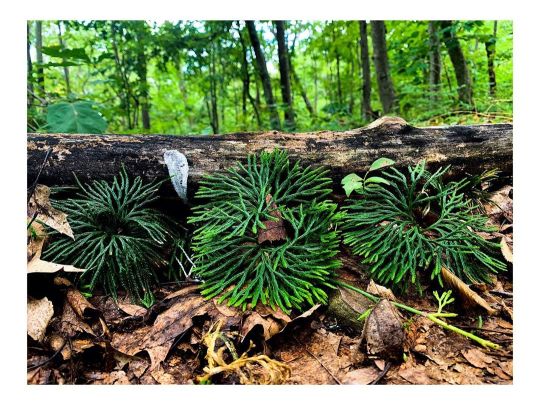
Diphasiastrum digitatum alsoknown as fan clubmoss, groundcedar, running cedar or crowsfoot #moss #appalachiantrail #poconosmountains #delawarerivergaprecreationalarea (at Mt. Minsi Trail) https://www.instagram.com/p/CDU-TxsnqSR/?igshid=1isxjvsga5neb
0 notes
Photo
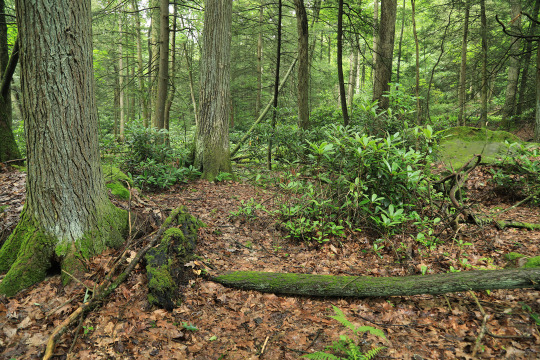

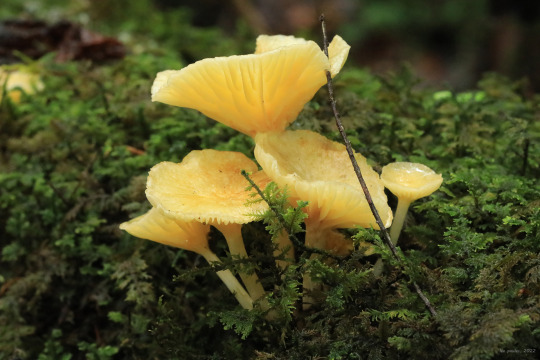
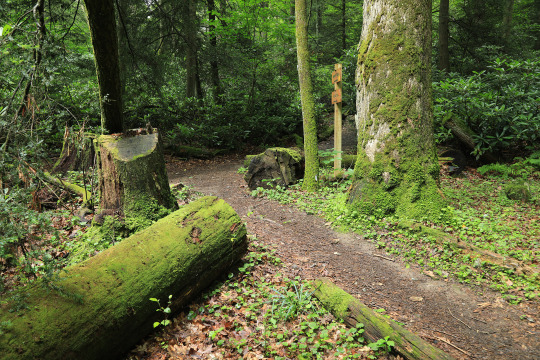

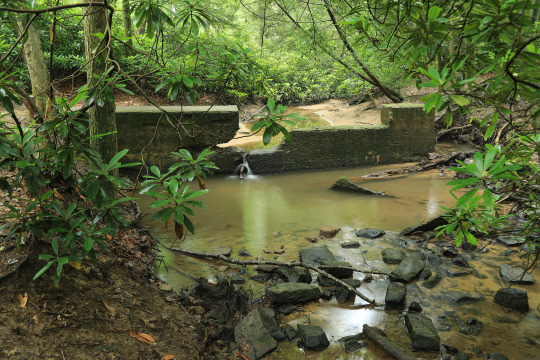

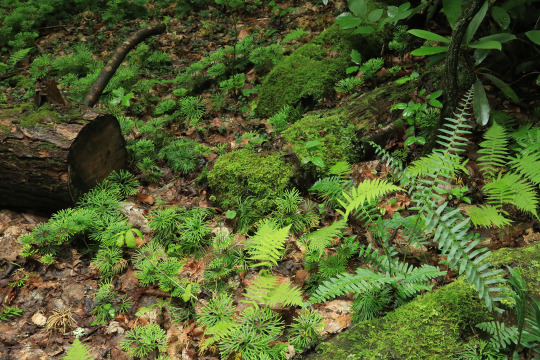


Tibbs Run Preserve, Panel 1 of 3. Beneath the moist dripping vaults of the primeval green cathedral gather the true believers: moss, fungi, and ferns. The old hemlock forest ministers silently, relentlessly to its devoted congregation, heathens and pagans all, and adorns the ruins of its trespassers in moss and rhododendron. None but nature shall endure.
#appalachia#vandalia#west virginia#summer#heat#moisture#green#fungi#ferns#clubmoss#rhodobryum ontariense#rose moss#diphasiastrum digitatum#fan clubmoss#artomyces pyxidatus#crown-tipped coral#laetiporus sulphureus#sulphur shelf#chicken-of-the-woods#tsuga canadensis#eastern hemlock#tibbs run preserve
128 notes
·
View notes
Photo

A plant adaptation is a genetic change within a plant that enables it to live longer in its environment. Pictured above is a Southern Ground Cedar plant, that is a part of the “fan clubmoss” family. These small plants can be found all throughout North American forest floors, and grow to only about four inches tall. They have adapted to live in disturbed forest floors due to their scale-like leaves and thick, glossy overcoats. They often avoid competition with other plants and predators because of this.
0 notes
Photo

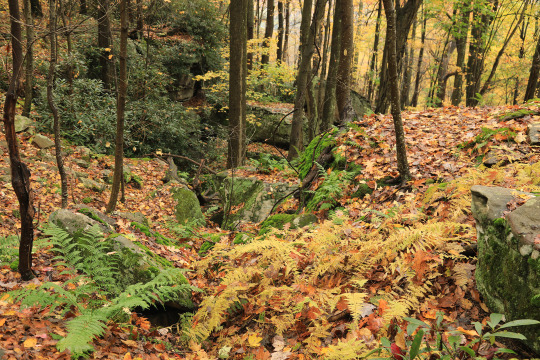

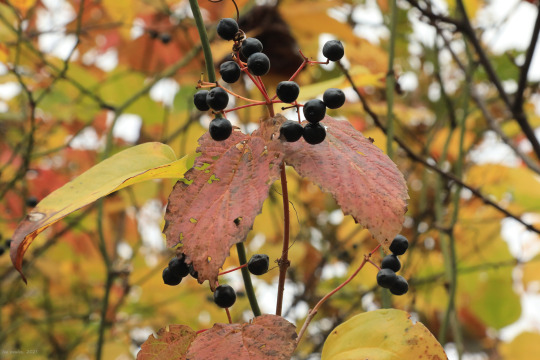


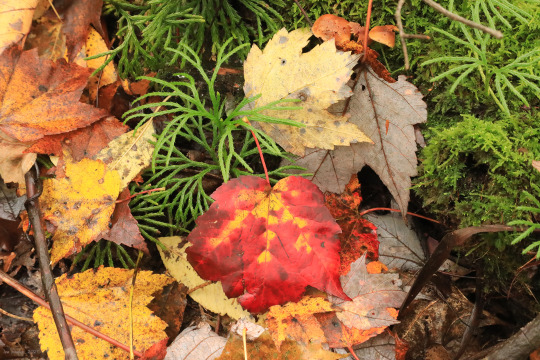

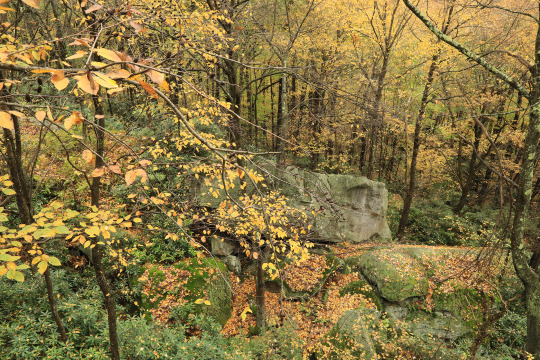
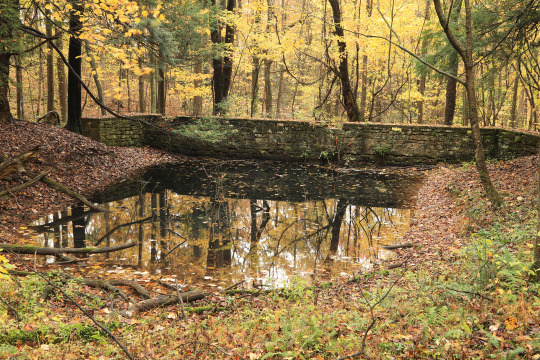
The foliage is now reaching peak color in the Cheat River Canyon.
Field notes:
1. Yellow is the predominant color in many sections of the canyon, especially where American beech, tulip poplar, sugar maple, witch hazel, and yellow and black birch are the dominant species. Sugar maple has a highly variable leaf color in the canyon, ranging from vibrant yellow to brilliant orange. In the rockier sections of the canyon, where it occurs with beech and birch, it seems to dress like its neighbors.
2. The oaks were just starting to go on Sunday, and will add some additional color this upcoming weekend - when everything should be at peak. Over the past decade or so, peak color in the local NC WV area has moved steadily from mid to late October to early November. Good article here on how climate change is dulling and delaying peak in some areas of the country. Higher elevations of the Alleghenies seem to be more resilient and have continued to change over in early October.
3. Mapleleaf viburnum (Viburnum acerifolium) is now firmly at the top of my list of favorite native shrubs. Everything about this plant fills me with joy, from its graceful, maple-like foliage to its somewhat balletic, clumping habit. In the spring, it produces the most enchanting bouquet of delicate white flowers with pink highlights. The flowers give way in the fall to iridescent blue-black berries, which contrast beautifully with the pastel-like red of its foliage. Fortunately for me, mapleleaf viburnum loves this canyon and is common throughout.
4. Eastern teaberry (Gaultheria procumbens), also sometimes called American wintergreen (not to be confused with striped wintergreen), carpets the acidic forest floor of the drier, oak-hickory woods in the canyon and adds a nice pop of green color (freckled with bright red berries) to the fallen leaves. The same is true of the various species of clubmosses that seem delighted to grow in the canyon, including fan clubmoss (Lycopodium digitatum), the most common variety.
5. Gray, drizzly overcast has been the rule for the past two weeks in NC WV. Normally, I would not be overly happy about that. But for some reason in the fall, it fits the mood and can actually bring out the leaf color even more. So I’m not going to bitch and instead be contented with what I have to work with.�� :-)
#appalachia#vandalia#west virginia#fall#autumn#foliage#snake hill wildlife management area#cheat river canyon#cheat river#chestnut ridge#viburnum acerifolium#mapleleaf viburnum#gaultheria procumbens#eastern teaberry#american wintergreen#lycopodium digitatum#fan clubmoss#climate change#climate resilience
122 notes
·
View notes
Photo

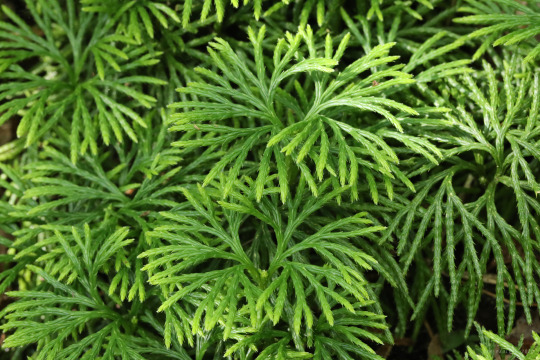
Fan clubmoss (Diphasiastrum digitatum), also known as ground cedar, spreads across the forest floor on long horizontal stems, which produce upright shoots with flat, fan-like, thrice-divided branches reminiscent of cedar leaves. In addition to the lush, beautifully-meshed carpet these ancient vascular plants make on a shady forest floor; their spores contain a flammable oil and were once used to create the explosive flash in magic shows. Photos above were taken on Snake Hill.
#appalachia#vandalia#west virginia#flora#lycopodiaceae#diphasiastrum#fan clubmoss#ground cedar#snake hill wildlife management area
1K notes
·
View notes